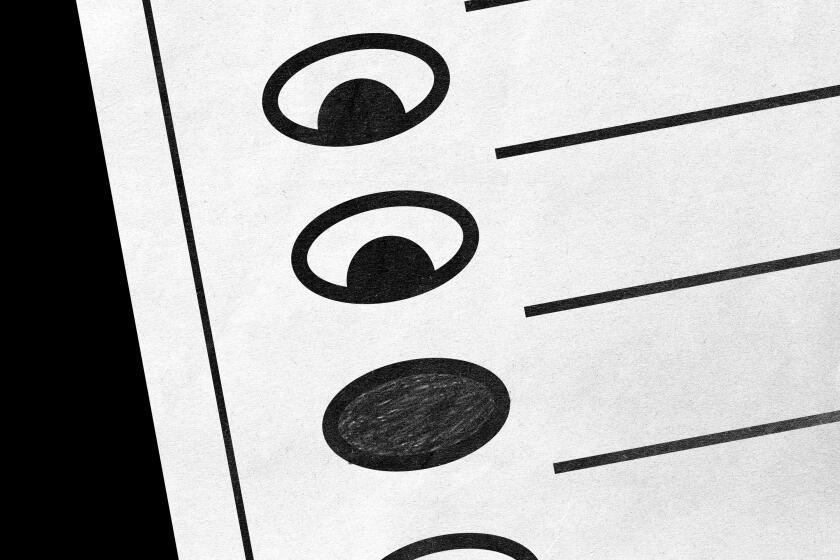Clean Air Act Revisions Passed by Senate, 89-11 : Environment: The compromise measure breaks a 10-year impasse and would impose tough new controls.
WASHINGTON — The Senate, bridging a decade-old division between economic and environmental interests, on Tuesday overwhelmingly approved a sweeping revision of the Clean Air Act that imposes tough new controls on automobile and industrial pollution in order to make the air in all American cities fit to breathe by the year 2010.
The far-reaching and still intensely controversial bill, the first revision of the nation’s clean air laws since 1977, was adopted by a vote of 89 to 11. Only a small group of Midwestern senators voted against it, citing concerns that its acid rain provisions will cost thousands of high-sulfur coal mining jobs in their states.
The most important and complicated legislation that Congress is likely to pass this year, the omnibus bill tightens a number of controls on the major sources of smog, acid rain and toxic air pollution in order to force the nation’s 100 most-polluted areas into compliance with federal air quality standards over the next 15 years.
The one exception would be Los Angeles, the nation’s smoggiest city, which would be given 20 years, until 2010, to achieve attainment.
“This is landmark legislation,” said Senate Minority Leader Bob Dole (R-Kan.). “Nothing else we do this year will surpass it.”
Senate Majority Leader George J. Mitchell (D-Me.), the Senate’s leading environmentalist and the driving force behind the bill, hailed the outcome as an “historic victory” for clean air and public health. Sen. Dave Durenberger (R-Minn.) said the bill’s enactment into law would make the United States “the cleanest of all industrial nations.”
“It cleans up everything from our power plants to our automobiles to our chemical plants in ways that people over the last 14 years said was not possible,” Durenberger said.
Both California senators, Republican Pete Wilson and Democrat Alan Cranston, voted for the measure.
The House is still drafting its version of the bill, with floor action not expected until next month. Some of the fierce battles that almost derailed the Senate bill will have to be refought on the House floor. But supporters of the legislation said it was now all but certain that a new Clean Air Act will be signed into law this year.
The vote was considered a major victory for Mitchell, who fought for years to bring clean air legislation to the floor. He also helped craft the complex compromise with the Bush Administration last month--a compromise that finally ensured Senate passage.
However, it was, as expected, strongly criticized by both environmental and business interests. Industry lobbyists complained it goes too far in imposing unbearable burdens on businesses, while environmentalists maintain it does not go nearly far enough to ensure its avowed aim of protecting public health.
Business lobbyists predicted the bill would cost many billions of dollars more to implement than the Administration estimates and said it could result in severe economic upheavals and the loss of at least 200,000 jobs in the industries hardest hit by the new regulations.
Environmentalists said the concessions made to win White House support for the bill had left it riddled with loopholes.
“This is no longer a bill that will achieve it’s aim of protecting public health or cleaning up the nation’s air,” said Richard Ayres, director of the National Resources Defense Council, an environmental lobbying coalition.
California environmental officials said they were disappointed because the changes negotiated by the White House left them without strong federal backup for the much tougher clean air regulations either already in effect or being planned for the state.
“The bill does not preclude us from carrying out our own plans, but to the extent that it could have extended those goals to the rest of the country, it would have made it much easier for us,” said Bill Sessa, an official with the California Air Resources Board.
Defending the compromise, Mitchell said the Senate faced only two choices: “This clean air bill or no clean air bill.” This bill, he added, “dramatically expands and strengthens” existing law in “the most cost efficient manner possible.”
Speaking to reporters aboard Air Force One before the Senate vote, President Bush said that in the clean air effort, “We are not going to go to either extreme: the extreme of throwing people out of work and shutting down America and stopping all economic growth, or the extreme of doing nothing about the terribly pressing environmental questions.”
Bush spoke during a flight from Indiana to Michigan, during a day of political speeches at fund-raising events in Indianapolis and Dearborn, Mich.
Rivalled only by the tax code in its complexity and scope, the bill takes a two-track approach to lowering levels of ozone, a major component of urban smog, by controlling emissions from both stationary and mobile sources of pollution.
It mandates the use of reformulated and cleaner-burning gasoline mixtures for cars in Los Angeles and eight other urban areas with the nation’s worst smog levels. It also expands the regulation of toxic chemicals, many of them carcinogenic, from the seven covered under current law to more than 190.
To curb acid rain, the focus of the bill’s strongest provisions, giant utilities in the Midwest would be required to cut sulfur dioxide emissions by 10 million tons, with a cap at 1980 levels, after the year 2000. The production and use of chlorofluorocarbons, the main class of chemicals responsible for the erosion of Earth’s protective ozone layer, would also be phased out by the Senate bill.
To achieve these reductions, the bill imposes restrictions that would affect virtually every major industry and touch the lives--and the pocketbooks--of American consumers in myriad ways both large and small. They effects range from raising the price of the cars they drive to determining what ingredients go into the hair sprays and deodorants they buy.
It will also cost a lot--anywhere from $21.5 billion per year by the Bush Administration’s estimate to more than twice that amount if the industry lobby’s figures are accurate.
But cost is only one aspect of a controversy that, trapped in a gridlock of competing political, regional and economic interests, has stalled the passage of clean air legislation in Congress at the committee level for the past 10 years.
The gridlock was finally broken at the end of 1988, when Mitchell, an ardent environmentalist, became majority leader and George Bush, newly elected as President, radically departed from Ronald Reagan Administration policies by calling for passage of tougher clean air laws.
A much stronger version of the bill drafted by the Senate Environment and Public Works Committee subsequently won the endorsement of environmentalists and public health groups but was strongly opposed by the White House as too expensive.
Calculating that he did not have enough votes to defeat a filibuster or override a threatened White House veto, Mitchell agreed to closed-door negotiations with the Administration that finally produced the clean air compromise last month.
SENATE VERSION OF CLEAN AIR BILL
The clean air bill passed by the Senate is substantially tougher than current law, but still weaker in many respects than regulations already in effect, or proposed for, California. Here is a comparison: AUTOMOTIVE EMISSIONS--Current law: Restricts tailpipe emissions of hydrocarbons and nitrogen oxides (NOx), major components of smog, to .41 grams per mile (gpm) for hydrocarbons, 1.0 gpm for NOx, and carbon monoxide to 3.4 gpm. California law: Restricts hydrocarbon emissions to .25 grams per mile, carbon monoxide to 3.4 grams per mile for the first 50,000 miles, phased in over a three-year period. Currently limits NOx emissions to 0.4 grams per mile. Another proposal not yet law but expected to be adopted would cut hydrocarbon emissions by an additional 50% beginning in 1997. Senate bill: Same emission reductions as California mandates for 1993, but another round of 50% emission cuts would go into effect in 2004 if 12 or more “seriously” polluted cities outside California remain above federally mandated ozone limits in 2001. ALTERNATIVE FUELS--Current law: No provision for alternative fuels in current law. California law: No current provisions. Regulations being developed would require cleaner gasoline for all cars by 1993 and the phase in of even cleaner alternative fuels beginning in 1994. Alternative fuels would be twice as clean as the cleanest gasoline then in use. Senate bill: Requires that new cars in the nation’s nine smoggiest cities run on a cleaner-burning reformulated gasoline mixture by 1994. Even cleaner fuel standards would be phased in for fleet vechicles in serious smog areas starting in 1995. ACID RAIN--Current law: No provisions for acid rain control currently in effect. California law: No provisions related specifically to acid rain, but state places limits on both NOx and sulfur dioxide emissions. Senate bill: Requires 107 polluting utilities in the Midwest and Southeast to cut sulfur dioxide emissions by 10 million tons in the year 2000, when emission levels would be capped at 1980 levels. Utilities also would cut NOx emissions by 4 million tons by 2005. Allowance system would let utilities reducing emissions below the required levels sell “pollution credits” to others. AIR TOXICS--Current law: Imposes controls on the emissions of seven chemicals classified as toxic. Enforcement has been lax. California law: State regulates same seven chemicals classified as toxic by federal law. The state also regulates two additional toxics not regulated by the federal government--benzene and chromium. State developing regulations for another seven, and studying 10 others for possible regulation.
More to Read
Get the L.A. Times Politics newsletter
Deeply reported insights into legislation, politics and policy from Sacramento, Washington and beyond. In your inbox three times per week.
You may occasionally receive promotional content from the Los Angeles Times.










